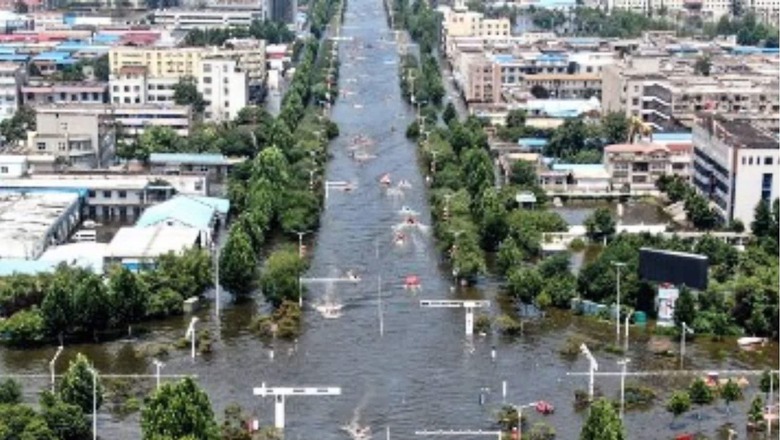
views
One of the most influential slogans given by Mao Zedong, the founder of the People’s Republic of China, was, “Man must conquer nature.” A book published by the Cambridge University Press, ‘Mao’s War Against Nature: Politics and the Environment in Revolutionary China’, written by Judith Shapiro, details how Mao led the foundation of a government policy in China that made waging war against nature one of its core policy measures.
Mao Zedong died in 1976, but China, it seems, made his words against nature a permanent policy directive, something that perfectly reflects in China’s rush to build all sizes of dams, which are infrastructural structures that try to contain nature.
But have they been able to conquer nature? It doesn’t seem that way.
Furious floods
The Zhengzhou floods are the perfect example. Zhengzhou is a major electronics production hub with the world’s largest iPhone assembly line. Floods have ravaged the city, which is also the capital of the Henan province.
Floods in this industrial city have officially killed 25 people so far, but the real count is expected to be much higher. Around 2 lakh people have been displaced and China, in spite of its tall claims of technological and infrastructural prowess, could not save the city’s roads and subways from submerging and collapsing while dams and reservoirs in the area saw significant damage. Power cuts in the city didn’t spare even hospitals. Overall, more than a million people have been displaced in the Henan province.
Clearly, nature’s fury like floods, droughts or earthquakes advise us to strike a much-needed balance with the environment; otherwise, humans would be the biggest losers because an overburdened nature means an invitation to destruction. But China doesn’t think so. In spite of massive floods in Henan and Zhengzhou, authorities kept on operating the underground railway tunnel that finally led to the death of 12 people after they were trapped in the floodwater. They thought the underground tunnel system could withstand any disaster. But, it too failed, much like the other infrastructure of the city of Zhengzhou.
Dam right!
And last month, China inaugurated its second-largest hydroelectric power station built on a dam in an area that is earthquake-prone. Built on Jinsha river, the upstream branch of China’s Yangtze river, the 289-metre high 16 GW Baihetan dam and hydropower station were built in just four years, even if the construction was considered an engineering challenge. The dam in southwestern China’s Liangshan, on the border of Yunnan and Sichuan, was built by the Three Gorges Corporation that runs the Three Gorges Dam, the biggest hydroelectric station in the world.
China, like in most of the other dams built in the country, has followed Mao’s words literally even here, even if it means a great loss to the ecological balance. The dam will slow down water flow and will damage the floodplains. Water will be more polluted with a large reservoir withholding the flow. This in turn will affect the survival of the fish by greatly disturbing their living conditions, says an analysis by ScienceMag.org. And it is going to affect human health in the long run.
Western China is known to be a high seismic zone with frequent occurrences of earthquakes. The region sees almost 82% of the earthquakes in modern China, says a United Nations analysis. And Baihetan dam falls in this region, on the earthquake-prone border of Sichuan and Yunnan provinces, with a large water reservoir. The total storage capacity of the Baihetan dam is 20.627 billion cubic metres, or 91% of the Jinsha river basin, says China’s official media Global Times.
Big dams like Baihetan with big reservoirs storing huge amounts of water mean increased chances of earthquakes and landslides, particularly when you claim to build the dam in just four years even if its construction was quite complex and an engineering challenge. The dam, in fact, looks like yet another example of China’s audaciousness to win over nature.
Consequences
Critics say China, in fact, didn’t even need the Three Gorges Dam. True, the dam generates 22.5 GW of energy and helps China meet its increased energy needs, but the main reason behind its construction was controlling floods, says an analysis published by CNN. The dam took 11 years of construction and was finally opened in 2006. But it failed to control the first massive flood that the Yangtze river basin saw in 2020 since the opening of the dam.
The Yangtze river basin saw the heaviest rainfall last year since 1961, but China failed to forecast even its impact that, in the end, deeply disturbed millions of lives. Flooding that started in June 2020 saw at least 219 people killed, 54,000 homes destroyed, around 4 million displaced and close to 63 million people affected by August 2020, as per official records. The floods caused a loss of around $30 billion dollars, according to official estimates. And this year again China is on high alert with the Yangtze river and its tributaries rising to dangerous levels with continuing intense rainfall.
The construction of the Three Gorges Dam that began in 1994 displaced 1.4 million people, submerging two cities, 114 towns and 1,680 villages. Resettlement has been a big issue as is evident from different critical media reports. The whole project, along with the hydroelectric power station, cost around $23 billion, China claims, but experts argue the real cost may be in the range of $40-50 billion.
As per a CNN analysis, Three Gorges can only hold around 9% of the total water, or 244 billion cubic metres, that passes through it when China sees big floods like the one in 2020. Also, it cannot hold water for long as more and more rain means more water coming into the reservoir area.
The result? The dam would be forced to release water to make space for more water coming down, even if it means increased flooding in the downstream areas of the river.
Three Gorges cannot prevent floods when nature’s fury is at its worst, and Mao’s words clearly fail. Three Gorges is no answer to the big floods caused by heavy rainfall spread over months as 2020 saw. Critics say its reservoir is too small for that and can only alleviate flood concerns in normal rainfall years.
Shaken up
Earthquakes are another significant threat that big dams like Three Gorges or Baihetan may spur. Though China has denied that the devastating 2008 Sichuan earthquake was caused by the Three Gorges project, the 410-mile long reservoir of the dam means more chances of earthquakes and landslides due to the huge weight of the water it holds and its varying levels in different weather conditions that puts pressure on the earth’s crust that put different stress on the earth’s crust. Change in stress with varying levels of water can trigger earthquakes. As per Global Times, the Three Gorges reservoir can hold 22 billion cubic meters of floodwaters, just slightly above the storage capacity of the Baihetan dam.
Scientists, in fact, have linked the 2008 Sichuan earthquake to China’s dam-building rush. In 2009, scientists in China and the US came up with research, which suggested that a dam, Zipingpu, was the reason behind the magnitude 7.9 earthquake that killed over 87,000 people. Zipingpu is a big dam collecting huge amounts of water that, according to a group of Chinese scientists, affected seismic activity in the area. The dam was 5.5 km away from the Sichuan earthquake epicentre. A Columbia University research from the US further said that 320 million tons of water collected in the dam put more pressure on the earth’s crust, affecting the seismicity of the area.
But China doesn’t accept such claims that question its infrastructural prowess, even if Zipingpu dam can hold only a fraction of the water compared to Three Gorges and Baihetan, with a storage capacity of 1.12 billion cubic metres. Mao called dams magnificent projects, and with his thoughts of conquering nature as the guiding light, China is currently the biggest dam builder in the world with 23,841 dams in the country, much ahead of the US’s 9,263.
Read all the Latest News, Breaking News and Coronavirus News here.

















Comments
0 comment